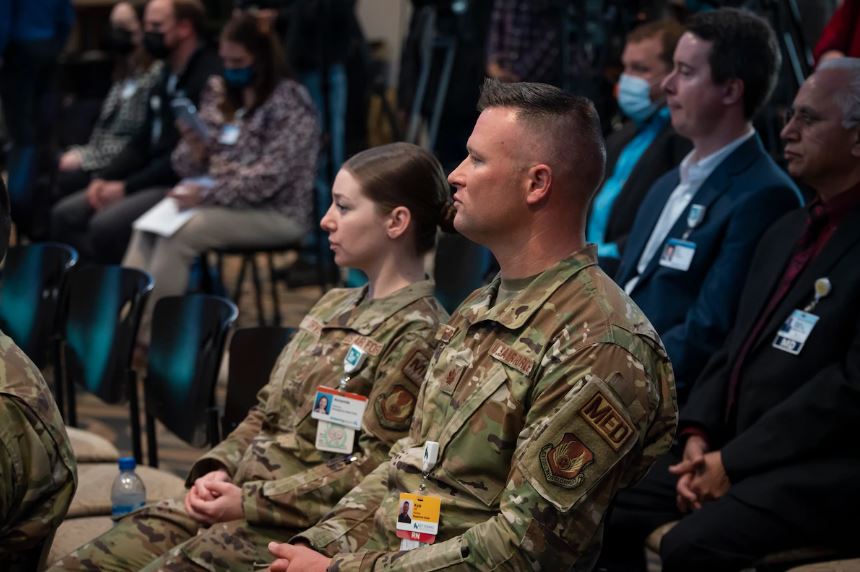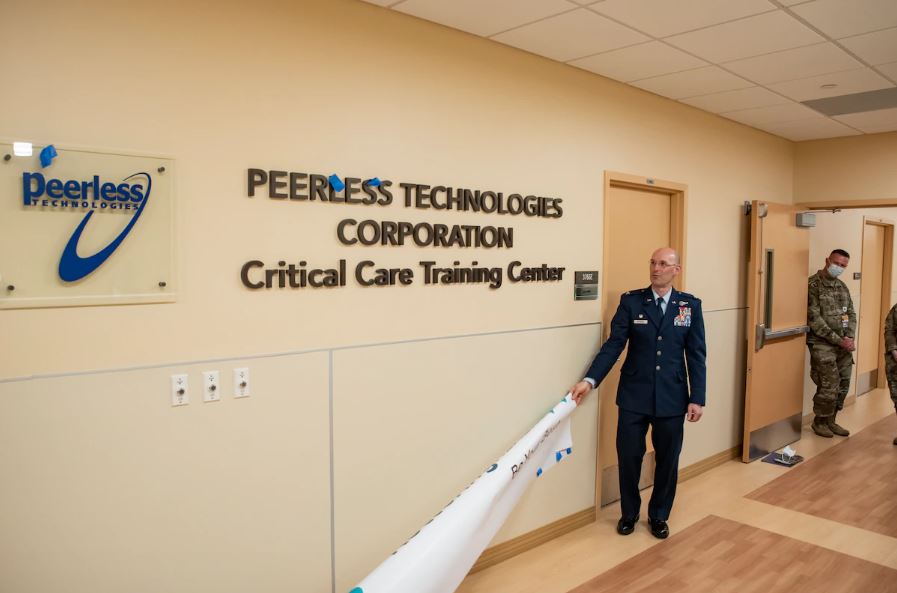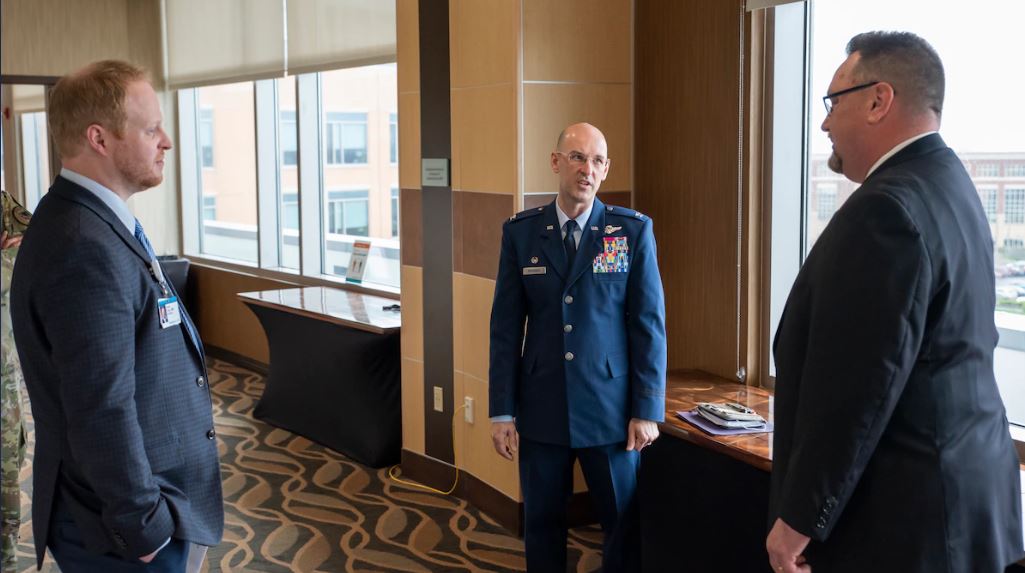AFRL leaders, Kettering Health network celebrate new Enlisted Critical Care Training Center
WRIGHT-PATTERSON AIR FORCE BASE, Ohio (AFRL) — The U.S. Air Force School of Aerospace Medicine (USAFSAM) and the Kettering Health Network celebrated the official opening of the Enlisted Critical Care Training Center located at Soin Medical Center on April 13, 2022.
A partnership between the Air Force and Kettering allows for each to “harness each other’s resources,” said Col. (Dr.) Tory Woodard, commander, USAFSAM, one of two mission units in the 711th Human Performance Wing, part of the Air Force Research Laboratory (AFRL).
The partnership is a complementary one, not only allowing service members to learn and grow, but also give back to the community.
“Currently one of our instructors is actually deployed and he will be returning soon,” Woodard said. “He will be able to bring that deployment medical knowledge and put that back into the civilian network. And also Kettering is able to train our technicians. So this is truly a symbiotic and mutual relationship where we are allowed to train, and we benefit from each other.”
The training center is made up of labs that recreate complex real-life situations for training and a chance to partner with the Air Force, as well as for the Soin Medical Center staff, said Daniel Tryon, president of Soin Medical Center and Kettering Health Greene Memorial.
“One of the awesome things about having some of the partnerships we have with Wright-Patt is consistently having men and women in uniform within our facility, and there is a learning experience that occurs where we get a chance to learn from them and it really betters how we provide care here at Soin Medical Center,” Tryon said.
The partnership began when the Air Force recognized the need to increase critical care technician training and Kettering presented an opportunity for a relationship with Wright-Patterson Air Force Base.
“Over the last 14 months really is when this started,” Woodard said. “So, a blank slate has been developed into this training facility over the last 14 months in association with the Kettering Health Network.”
And while this is the newest location of six sites that USAFSAM runs, this is a very unique site, Woodard added.
“It is the first and only enlisted critical care technician course that we have,” said Woodard. “It’s the first one, and the only one, that trains these critical care technicians for our needs throughout the U.S. Air Force and really for the DOD, it’s kind of a unique asset.”
There will be 10 courses a year with 10 technicians for a four-week course, where the students will receive a combination of didactics, lectures and high fidelity simulations with manikins before direct patient care.
“The [simulation laboratory] in this program allows us to train our enlisted technicians to become critical care technicians, which allows us to make sure that we have the available medical resources in any contingency operation whether that is peacetime, wartime and natural disasters,” said Woodard.
Through the sim-lab, technicians learn to respond to any situation; whether it be a humanitarian disaster, natural disaster or other unfortunate event, the technicians will be “training and ready to respond,” Woodard said. “Through that development of the network, we are able to harness each other’s resources and surge as needed to make sure that we support both the community, that we are embedded in, and that we are also able to support and provide technicians anywhere anytime with the medical training that they need to do their job.”
Maj. Kyle Perry, chief of the enlisted critical care division, USAFSAM, is an ICU nurse and instructor of didactic portions of the Enlisted Critical Care Training in the classroom and sim lab.
Now that the course is up and running, Perry said the goal is to keep the program going and ensure continuous improvement since critical care technicians in the Air Force are integral to the team. In the Air Force’s ICU, the team consists of a doctor, nurse and a critical care technician.
“We also have some other entities, but that’s kind of the core,” Perry said. “And that’s how we practice it stateside, globally, whether it’s peacetime [or] deployed locations, that’s how we practice. So, it’s imperative that we train those critical care technicians in a network that’s capable of providing that clinical experience for them, along with our instruction.”
Kettering working hand-in-hand with the Air Force benefits the local community in a variety of ways.
“The very training we are working so hard to build and then to train our students, we essentially infuse that back into the community,” said Perry. “Because that’s where our training takes place, it’s in the Kettering network. The people of the local community benefit directly from our training that we are doing for the Air Force because we are doing it right here in their patient care environments.”
Be sure to follow AFRL on social media at Facebook, Twitter, LinkedIn, Instagram and YouTube @afresearchlab.
About AFRL
The Air Force Research Laboratory (AFRL) is the primary scientific research and development center for the Department of the Air Force. AFRL plays an integral role in leading the discovery, development, and integration of affordable warfighting technologies for our air, space, and cyberspace force. With a workforce of more than 11,500 across nine technology areas and 40 other operations across the globe, AFRL provides a diverse portfolio of science and technology ranging from fundamental to advanced research and technology development. For more information, visit: www.afresearchlab.com.
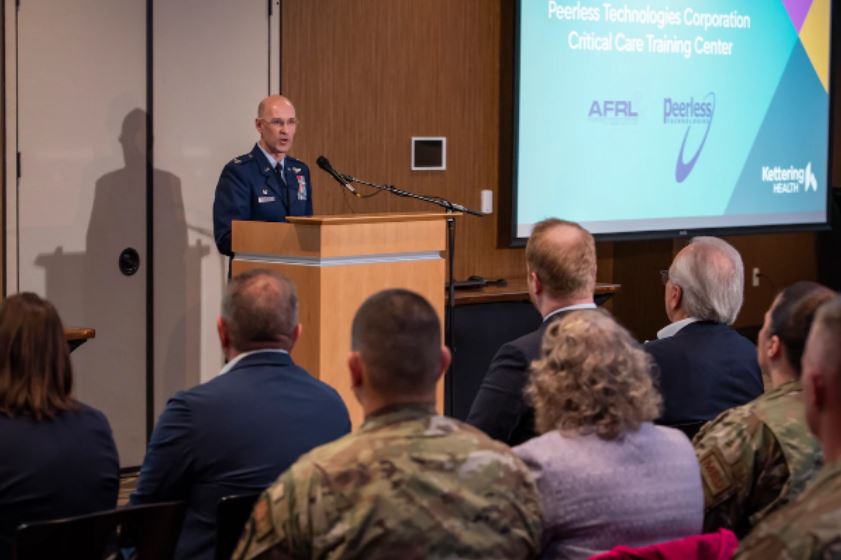
Col. Tory Woodard, center, commander, U.S. Air Force School of Aerospace Medicine, makes a speech during the official opening of the Enlisted Critical Care Course (EECC) at the Soin Medical Center April 13, 2022, in Beavercreek, Ohio. USAFSAM is one of two mission units in the 711th Human Performance Wing, part of the Air Force Research Laboratory (AFRL). AFRL and Kettering Health Network partnered to create a training wing at Soin Medical Center, which allows the Air Force to received training as critical care technicians and also give back to the community. There are 10 courses in a year with 10 technicians each, and the four-week course provides didactics, lectures, simulations and real-patient care. (U.S. Air Force photo / Richard Eldridge)
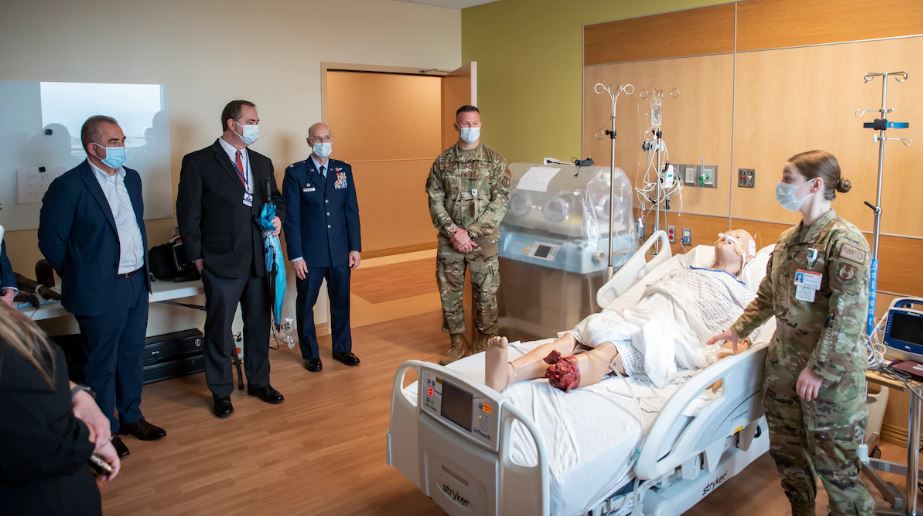
Master Sgt. Amanda Orvis, right, superintendent, Enlisted Critical Care Course (EECC), U.S. Air Force School of Aerospace Medicine; and Maj. Kyle Perry, center, chief of enlisted critical care division, USAFSAM, give officials, including Col. Tory Woodard, left-center, commander, USAFSAM, a tour of the new training space during the official opening of the EECC at the Soin Medical Center April 13, 2022, in Beavercreek, Ohio. USAFSAM is one of two mission units in the 711th Human Performance Wing, part of the Air Force Research Laboratory (AFRL). AFRL and Kettering Health Network partnered to create a training wing at Soin Medical Center, which allows the Air Force to received training as critical care technicians and also give back to the community. There are 10 courses in a year with 10 technicians each, and the four-week course provides didactics, lectures, simulations and real-patient care. (U.S. Air Force photo / Richard Eldridge)
Master Sgt. Amanda Orvis, left, superintendent, Enlisted Critical Care Course (EECC), U.S. Air Force School of Aerospace Medicine; and Maj. Kyle Perry, chief of enlisted critical care division, USAFSAM, listen to speeches during the official opening of the EECC at the Soin Medical Center April 13, 2022, in Beavercreek, Ohio. USAFSAM is one of two mission units in the 711th Human Performance Wing, part of the Air Force Research Laboratory (AFRL). AFRL and Kettering Health Network partnered together to open this site. The site is one of six external USAFSAM sites, but this one is the first-ever of its kind. Partnering with the Kettering Health Network to create a training wing at Soin Medical Center allows the Air Force to received training as critical care technicians and also give back to the community. There are 10 courses in a year with 10 technicians each, and the four-week course provides didactics, lectures, simulations and real-patient care. (U.S. Air Force photo / Richard Eldridge)
Col. Tory Woodard, center, commander, U.S. Air Force School of Aerospace Medicine, helps to reveal the new sign distinguishing the official opening of the Enlisted Critical Care Course (EECC) at the Soin Medical Center April 13, 2022, in Beavercreek, Ohio. USAFSAM is one of two mission units in the 711th Human Performance Wing, part of the Air Force Research Laboratory (AFRL). AFRL and Kettering Health Network partnered to create a training wing at Soin Medical Center, which allows the Air Force to received training as critical care technicians and also give back to the community. There are 10 courses in a year with 10 technicians each, and the four-week course provides didactics, lectures, simulations and real-patient care. (U.S. Air Force photo / Richard Eldridge)
Master Sgt. Amanda Orvis, left, superintendent, Enlisted Critical Care Course (EECC), U.S. Air Force School of Aerospace Medicine; and Maj. Kyle Perry, chief of enlisted critical care division, USAFSAM, listen to speeches during the official opening of the EECC at the Soin Medical Center April 13, 2022, in Beavercreek, Ohio. USAFSAM is one of two mission units in the 711th Human Performance Wing, part of the Air Force Research Laboratory (AFRL). AFRL and Kettering Health Network partnered together to open this site. The site is one of six external USAFSAM sites, but this one is the first-ever of its kind. Partnering with the Kettering Health Network to create a training wing at Soin Medical Center allows the Air Force to received training as critical care technicians and also give back to the community. There are 10 courses in a year with 10 technicians each, and the four-week course provides didactics, lectures, simulations and real-patient care. (U.S. Air Force photo / Richard Eldridge)

